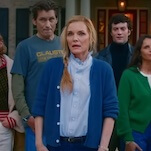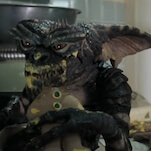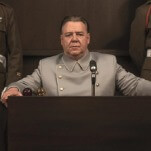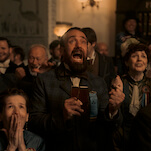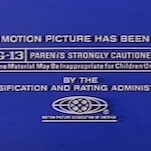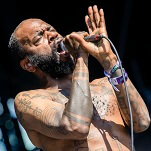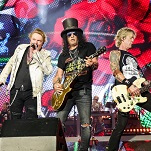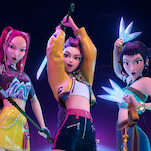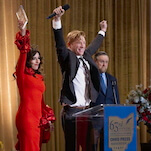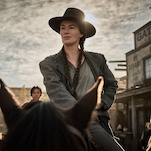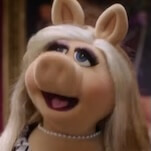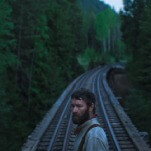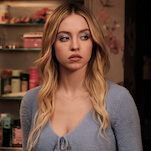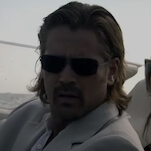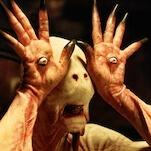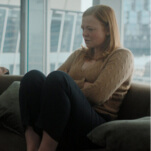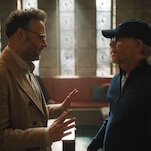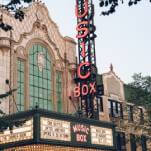On Monday, we started counting down our top 50 films of the 1990s, which we tabulated by blind votes among the film-writing staff. Following parts one and two, here’s the last of the batch: our most acclaimed films of the decade.
10. Being John Malkovich (1999)
For years, Charlie Kaufman’s screenplay for Being John Malkovich enjoyed a mixed reputation as a script far too brilliant and original to ever get made. The prevailing wisdom held that the script was too weird, dark, and meta to ever make it onto the big screen, even if the filmmakers did somehow manage to get an actor as prickly and difficult as Malkovich to play a version of himself as a sketchy, narcissistic, sex-obsessed jerk. Thankfully, a music-video prodigy named Spike Jonze soldiered on and brought Kaufman’s dizzyingly original, wickedly postmodern vision to the screen with a remarkable cast headlined by John Cusack, Cameron Diaz, Orson Bean, Catherine Keener, and, yes, Malkovich himself in one of the greatest extended acts of self-deprecation in film history. Cusack and Diaz diligently strip away any remaining vestige of movie-star glamour or vanity and embrace internal and external grunginess, playing a couple leading lives of sad, sour desperation before they discover a magical portal into the mind of John Malkovich that turns their lives upside down and kick-starts a strange wave of sexual role-playing and competition involving their shared object of desire, a cynical opportunist played by Keener. In his feature debut, Jonze takes the script’s absurdist, surreal flights of fancy and thoughtful ruminations on fame, jealousy, and ambition and grounds them in all-too-human emotions and a fully fleshed-out vision of the world as a Darwinian nightmare ruled by fear, greed, lust, anxiety, and uncontrollable compulsions.
9. Rushmore (1998)
The template for how “a Wes Anderson film” looks and feels was established with the director’s second feature, Rushmore, a quirkily personal movie about a private-school misfit (played by Jason Schwartzman) who enters into a complicated mentor/protégé relationship with depressed local businessman Bill Murray. What stands out immediately about Rushmore is its style, which is consciously theatrical at times and populated by characters who dress and act like they stepped out of the pages of a mid-20th-century juvenile novel. But, as with Anderson’s subsequent films, some viewers overlook Rushmore’s depth of feeling. Anderson and his co-writer, Owen Wilson, are pining for an adolescence that never was, one they only experienced via comic strips, British youthsploitation movies, and old copies of The New Yorker. But they don’t ignore how the messy realities of the adult world make that pop utopia all but impossible to attain, aside from a few fleeting moments.
8. Unforgiven (1992)
Clint Eastwood walked away from Westerns after Unforgiven, and it’s not hard to see why: What was left to say after this? Working from a script by David Webb Peoples that dated back to the ’70s, Eastwood made the film into a wintry study of a genre in which the lawlessness of the frontier does battle with the civilizing law and order of those attempting to settle it. But, as many Westerns before realized, the conflict was rarely so simple. Eastwood plays a retired gunfighter who, as the film opens, has put his bad old killing days behind him for the quiet life of a farmer. But farming isn’t easy and, absent the civilizing influence of his late wife to keep him on the righteous path, he accepts a gun-for-hire job. It at least sounds like a just cause: collecting a bounty by killing two cowboys who mutilated a prostitute and received only a slap on the wrist from the sheriff (Gene Hackman) for their crimes. The closer Eastwood comes to his goal, however, the more tangled the issue becomes, as he comes ever closer to tumbling back into his old life.
Eastwood became an international star playing The Man With No Name in a string of films for Sergio Leone that turned the Western into crudely beautiful pop art. They also made little attempt to hide the ugliness and cruelty of the American frontier, paving the way for the revisionist Westerns that followed. In many ways, Unforgiven closes the chapter on both Eastwood’s larger-than-life ’60s Western roles and on the way the genre was brought down to earth in the following decade, putting archetypal characters—the sharpshooter, the tough lawman, the merciless killer, the feckless kid—under the microscope to see what makes them work. In addition to working as a chilly, bloody drama, it’s also an intense study of what kind of people carved out the West, the unpleasant circumstances and moral compromises of the carving, and whether their sins linger on, both in their hearts and in our own history.
7. Reservoir Dogs (1992)
From its opening deconstruction of “Like A Virgin” to its climactic parody of the Mexican standoff, Quentin Tarantino’s stunningly assured debut puts a fresh spin on the heist movie—so fresh, in fact, that the heist itself isn’t even depicted. Instead, a handful of nattily attired hoods (played by a dream cast of character actors, including Harvey Keitel, Steve Buscemi, and Tim Roth) pace the budget-conscious warehouse set trading profane, discursive arias of paranoia and distrust, while judiciously placed flashbacks reveal crucial backstory and the identity of the undercover cop in their midst. Churlish fans of Hong Kong action cinema accused Tarantino of having pilfered Ringo Lam’s City On Fire, but two decades later, the charge seems absurd; it’s abundantly clear now that Tarantino is essentially a pastiche artist, and Reservoir Dogs saw him emerge fully formed, drawing from his encyclopedic knowledge of obscure genre flicks to create something uniquely his own. It’s all here: the digressive pop-culture debates, the fetishization of ’70s music (via Steven Wright as radio’s most ironically phlegmatic DJ), the playful tinkering with dramatic structure, and the climactic surge of genuine emotion that sneaks up on viewers from a thicket of clever badinage. Mr. Blonde’s harrowing torture-dance to Stealers Wheel got all the attention, but it’s the tender bond between ever-loyal Mr. White and gut-shot Mr. Orange, and its tragic resolution, that truly cuts deep.
6. Out Of Sight (1998)
Who would have guessed that Steven Soderbergh would have such a way with movie stars? He’d worked with name actors before, but in Out Of Sight, he showcases George Clooney and Jennifer Lopez as the charismatic, sexy, impossibly good-looking pair that they are. Clooney and Lopez loom larger than life as an escaped bank robber and a U.S. Marshal playing a game of cross-country chase. Out Of Sight is resolutely contemporary, from the warm, sleek surfaces of its cinematography to its diced-up timeline, but it has an old-fashioned quality to it. Clooney and Lopez are on opposite sides of the law, but they have the sparking chemistry of screwball-comedy leads from the moment they end up locked in a car trunk together. Despite there seemingly being no scenario in which the competent criminal who just can’t go straight and the equally capable cop with a taste for bad boys could waltz off together into the sunset, viewers root for them as a couple because they seem, in the all the best ways, to belong together. Though the weight of this hope grows heavier as the climax approaches, the film manages to pull off an ending that’s satisfying without requiring either of the characters to compromise who they are. With Out Of Sight, Soderbergh proved that sometimes the most experimental thing a filmmaker can do it try to make a commercial movie.
5. Chungking Express (1994)
Dazed and dreamy with urban romance and memory, Chungking Express is enough to make any moviegoer fall for Wong Kar-wai and his particularly cinematic vision of Hong Kong. Shot in the crowded, compact landscapes of the city’s Central and Tsim Sha Tsui neighborhoods, Chungking Express offers up a pair of languid, half love stories tied together by a shared location, which unfold amid an atmosphere of loneliness and longing so heavy you can practically run your fingers through it. Takeshi Kaneshiro muses about canned pineapple and his ex-girlfriend and tries to woo a drug smuggler played by Brigitte Lin, while Faye Wong breaks into an oblivious Tony Leung’s apartment to secretly redecorate and help him get over his own heartbreak. Characters don’t always neatly come together in Chungking Express, but the film finds a palpable impact to the ways in which they glance off each other in a city thick with people and possibility, but not connection. In terms of sheer sensuality, there’s nothing to rival Wong’s film, which is the definition of “lush,” from its gorgeous Christopher Doyle cinematography to the pop songs its characters love to the incredible watchability of its leads.
4. Dazed And Confused (1993)
Slacker marked Richard Linklater as a filmmaker with the ability to make esoterica meaningful; Dazed And Confused showed he could apply those skills to characters and a story that resonated beyond a community of grad students and eccentric artists. Set over the course of one day in 1976—the last day of school for a group of suburban Texas high-schoolers—Dazed And Confused takes the crowd-pleasing form of a ’70s/’80s teencom, driven by simple quests like “finding a party” and “not getting an ass-whooping.” But Linklater frames both adolescence and the ’70s from the perspective of a sympathetic but wiser older man who rues what’s going to become of these kids in the years and decades to come, even though he enjoys hanging out with them while they’re still young and relatively ignorant. The ’90s were awash in ’70s nostalgia, but Dazed And Confused did more than just revel in polyester kitsch. Linklater showed the times for what they were: uniquely decadent in some ways, but also a backdrop for the same mini-dramas that continue to play out in American teenagerdom.
3. Toy Story 2 (1999)
Pixar Animation Studios made its first foray into feature filmmaking with 1995’s Toy Story, a fine, funny film with authentically touching scenes. But Toy Story 2 is a rare case of a sequel improving on the original. Without losing the first film’s big cast, snappy dialogue, energetic pace, or zippy gags, it delves deep into the emotional resonance of broken relationships and unrequited love—a tall order for an animated children’s film about the shenanigans toys get up to when people aren’t looking. At its most emotionally ambitious, it’s a sweet, sad, impressively empathetic portrait of how much abandonment hurts, and how it affects the psyche. But at the other end of the spectrum, it’s a terrific adventure with an endlessly playful sense of humor. While 2010’s Toy Story 3 brought even more emotional impact and a more clearly expressed message about the continuity of generations and the passage of time, a good part of its impact came from the quality of its predecessors, how they built a family of characters, and how their relationships developed over time, letting viewers who were young when Toy Story hit theaters grow up alongside the franchise. Still, on a standalone basis, Toy Story 2 is the strongest of the three.
2. Pulp Fiction (1994)
If you’re looking for a watershed moment in ’90s cinema, Quentin Tarantino’s Pulp Fiction was the movie that changed everything, elevating genre trash into Palme D’Or-winning pop art, creating a referential universe unto itself, forcing a cultural dialogue on violence, and elbowing its way past the overwhelmingly genteel fare of American arthouses. It also spawned countless imitators (2 Days In The Valley, anyone? Things To Do In Denver When You’re Dead? Bueller? Bueller?), but Tarantino’s confident bravado as writer and director proved impossible to replicate, as did his elegant structuring of three interconnected stories that function together and apart. It almost seems incidental that he also happened to revive the career of the one of the ’70s’ biggest stars, John Travolta, who reclaimed his cool as a hitman who takes his boss’ wife (Uma Thurman) on one wild night on the town. The other two stories—the first about a boxer (Bruce Willis) who opts against throwing a fight, the second about Travolta and his partner (Samuel L. Jackson) disposing of a body—fold into a sprawling vision informed equally by Tarantino’s affection for sordid exploitation films and the playful avant-garde impulses of Jean-Luc Godard. And has there been another ’90s film so replete with future cultural touchstones? The dance scene at Jack Rabbit Slim’s, the exchange about the French McDonald’s and its “Royale with cheese,” the “gold watch” monologue, the adrenaline shot, Zed and “the gimp” in the pawn-shop basement. The “cinema of cool” has no greater avatar.
1. Goodfellas (1990)
If a film’s ability to remain as thrilling on the 15th viewing as on its first were reason enough to top this list, Goodfellas would have no competition. Yet as entertaining as the film remains each time around, every return trip also reveals how much is at work in Martin Scorsese’s decades-spanning mob drama, which doubles as a history of the mafia’s rise and fall as well as an exploration of what it takes to make it in America. Adapted from a book by journalist Nicholas Pileggi, Goodfellas recounts the true story of mobster-turned-informant Henry Hill, who begins the film as a starry-eyed kid who sees the local tough guys as celebrities and ends it in suburban exile, far from the glamorous aspirations of his youth. But, for a while, he gets to live the fantasy of having it all for nothing. Played as a grown-up by Ray Liotta, Hill falls in with a crew that includes Robert De Niro (effective in a flashless performance) and hothead Joe Pesci. The easy life gets a little harder as the years roll by: Pesci’s hubris causes the crew to fall from favor, big scores sour, drugs enter the picture, the game gets rougher—and then there’s all that work to be done, and someone has to find time to braise the beef and veal for the sauce and stir it so it doesn’t stick.
Purely as a piece of filmmaking, it’s a breathtaking work, filled with stunning sequences that have the look and feel of movies unto themselves. (In subsequent years, filmmakers have borrowed liberally from its most famous stretches: the long Copacabana take, the jittery editing of the coked-out climax, Pesci’s seeming offense at being considered a clown, and so on.) Scorsese masterfully weaves the film’s disparate elements into a single, cohesive story of desire and its consequences, a tale of those who dream big dreams and don’t mind stepping on some heads to make the dreams come true. It’s a morality tale without over-moralizing that seduces viewers into sharing Hill’s fantasy of a life without consequences, and then lets a hammer shatter his world into pieces.
Next: The list of orphans and outliers, where the cinema writers each champion four of their favorite films that didn’t get enough votes to make the master list. Read our first 20 films
here and our second 20 films
here. Listen to what we have to say about how the decade changed cinema
here, and see the '90s films we hate the most
here.




















